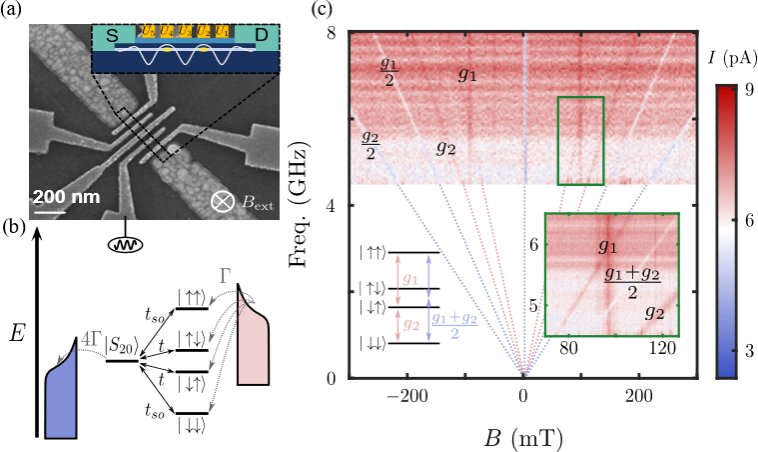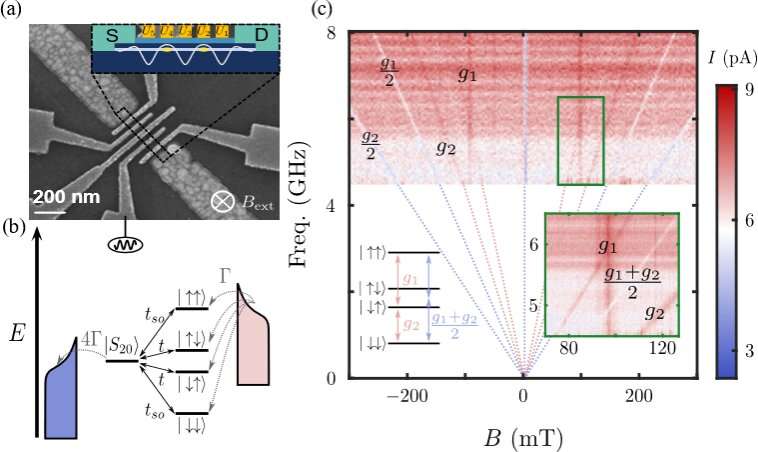

A research team has achieved coherent population trapping (CPT) in a semiconductor double quantum dot (DQD) system.
CPT is an important phenomenon of quantum interference, which was first observed in a three-level atom in an optical experiment. In such a three-level system, two states are coupled to a third intermediate state. When the frequency and phase of the driving field are properly tuned, the first two states form a superposition state that decouples from the intermediate state. This superposition state is known as the “dark state” as it does not respond to the probe field, giving rise to intriguing phenomena such as electromagnetically induced transparency.
The dark state has important applications in quantum information processing, but hasn’t been well implemented in DQD systems. Unlike the traditional three-level atomic system, the internal structure and dynamics of DQD can realize intrinsic CPT without an external driving field, making it a promising platform for quantum computing.
To implement CPT in the DQD system, the team leveraged the intrinsic properties of the energy levels in Ge and Si systems. Without any driving field, they measured the leakage current through the DQD in the Pauli Spin Blockade (PSB) and observed a significant dip in the current at zero bias, indicating the formation of dark states and the occurrence of CPT. Furthermore, the team demonstrated the ability to selectively create a dark state and the related CPT process by applying a longitudinal drive to the DQD system.
The team also delved deeply into the odd-even effect induced by a longitudinal driving field. Researchers observed that when the driving frequency meets certain conditions, the current exhibits enhancement or suppression corresponding to odd or even orders of harmonics.
This phenomenon offers a fresh perspective for understanding and utilizing CPT. Additionally, the team found that the signal intensity and width of CPT can be effectively modulated by adjusting the longitudinal driving field.
The realization of CPT in the DQD system shows that the semiconductor quantum dot system is not only an ideal platform for understanding quantum interference but also a powerful tool for high-precision quantum information processing. This work clearly demonstrates the potential tunability of the longitudinally driven DQD system, paving the way for practical application of semiconductor quantum dot systems in quantum computing.
The findings are published in the journal Nano Letters.
The team was led by Guo Guangcan, Prof. Guo Guoping and Prof. Li Haiou from the University of Science and Technology of China (USTC), collaborating with Researcher Zhang Jianjun from the Institute of Physics of the Chinese Academy of Sciences (CAS).
More information:
Yuan Zhou et al, Quantum Interference and Coherent Population Trapping in a Double Quantum Dot, Nano Letters (2024). DOI: 10.1021/acs.nanolett.4c01781
Provided by
University of Science and Technology of China
Citation:
Researchers achieve tunable coherent population trapping in a double quantum dot system (2024, October 16)
retrieved 17 October 2024
from https://phys.org/news/2024-10-tunable-coherent-population-quantum-dot.html
This document is subject to copyright. Apart from any fair dealing for the purpose of private study or research, no
part may be reproduced without the written permission. The content is provided for information purposes only.